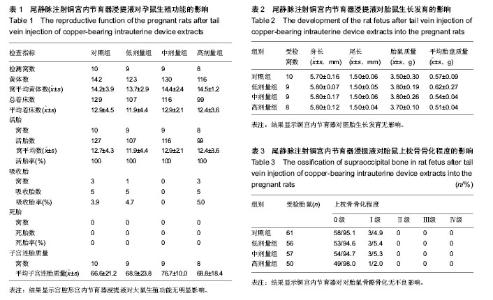| [1] 傅晓敏,黄丽丽.宫内节育器现状[J].中国妇幼健康研究, 2006, 17(3): 241-244.
[2] Progress in Reproductive Health Research (SHR).China to upgrade its IUD technology.2002;60:4.
[3] 尉建霞,韩丽晖.含铜宫内节育器的远期安全性研究[J].中国计划生育学杂,2007,2(136):122-123,128
[4] 吴尚纯.宫内节育器的应用进展[J].国际生殖健康/计划生育杂志, 2009,28(2):75-77.
[5] 张华,王召旭.含铜宫内节育器子宫角植入后局部反应的早晚期评价[J].中国组织工程研究,2012,16(8):1407-1412.
[6] Cao BM,Xi TF,Zheng YD.Release behavior of cupric ions for TCu380A and TCu220C IUDs.Biomed Mater. 2008;3(4): 044114(7pp).
[7] Cao B,Zheng Y,Xi T,et al.Concentration-dependent cytotoxicity of copper ions on mouse fibroblasts in vitro: effects of copper ion release from TCu380A vs TCu220C intra-uterine devices.Biomed Microdevices. 2012;14(4): 709-720.
[8] Cao BM,Xi TF,Zheng YD,et al.Cupric ion release and cytotoxicity for Yuangong Cu-IUDs and the release behavior of indomethacin for medicated 220 Cu-IUD.Chinese Sci Bull. 2009;54(18):3160-3166.
[9] 黄江涛,廖伟英,王奇玲,等.3 种含铜宫内节育器的临床效果及影响因素[J].中国妇幼保健,2011,26(10):1508-1511.
[10] 王兰,杨翠.三种含铜宫内节育器临床效果观察[J].中国医学创新, 2012,9(9):22-23.
[11] 岳帮静.含铜宫内节育器与金属宫内节育器的比较[J].齐齐哈尔医学院学报,2006, 27(15):1837.
[12] 吴尚纯,邹燕.宫内节育器应用现状与研究进展[J].中国实用妇科与产科杂志, 2009,25(10):795-797.
[13] 茹红瑞.三种含铜宫内节育器的临床效果[J].职业与健康, 2011, 27(19):2277-2278.
[14] 曹变梅,奚廷斐.不同含铜宫内节育器在模拟宫腔液中的铜离子释放研究[J].中国药事,2012,26(1):22-24,34.
[15] 楚光华,吴尚纯.含铜宫内节育器的生物安全性[J].中国计划生育和妇产科,2013,5(4):24-26.
[16] 曹变梅,奚廷斐,郑裕东.含铜宫内节育器铜丝和铜套在模拟宫腔液中的腐蚀[J].中国组织工程研究与临床康复, 2009,13(29): 5691-5694.
[17] 卫生部药政管理局,生物材料和医疗器械生物学评价技术要求[Z].1997年11月04日.
[18] 中华人民共和国卫生部药政局,新药(西药)临床前研究指导原则汇编(药学、药理学、毒理学)[Z].1993年7月.
[19] GB/T 16886.3-2008医疗器械生物学评价-第3部分:遗传毒性、致癌性和生殖毒性试验.
[20] 奚廷斐,辛仁东,薛淼,等.医疗器械生物学评价[M].北京:中国质检出版社,中国标准出版社,2012:1-49,196-202.
[21] GB/T 16886.12-2005医疗器械生物学评价-第12部分:样品制备与参照样品.
[22] 吴德生,董奇男,衡正昌,等.在致畸研究中小鼠胎鼠发育迟缓的评价指标[J].四川医学院学报,1984,15(1):59-63.
[23] GB/T 16886.1-2001医疗器械生物学评价-第1部分:评价与试验的定义.
[24] 国家食品药品监督管理局,医疗器械注册管理办法[Z].2004;局令第16号. |

